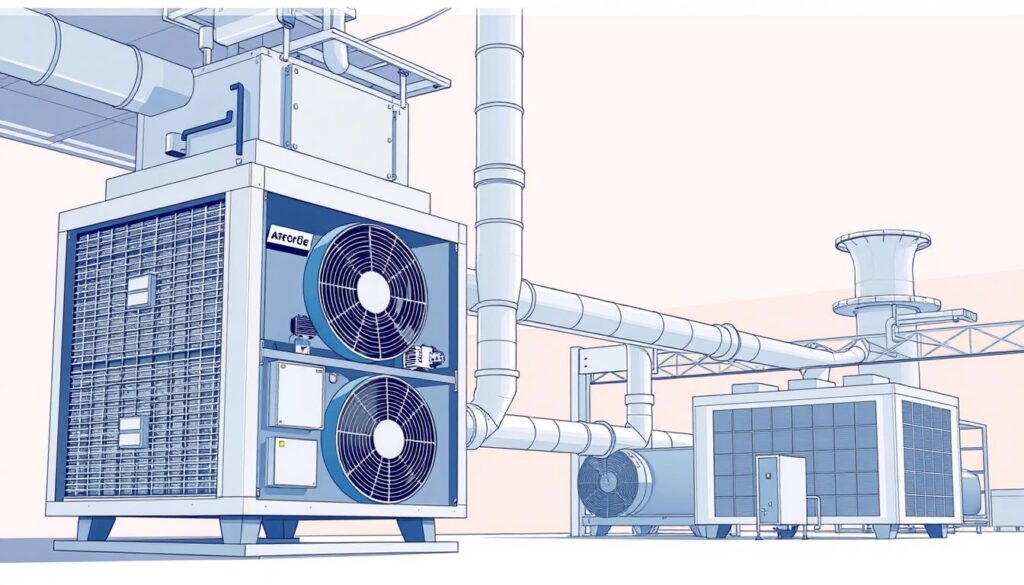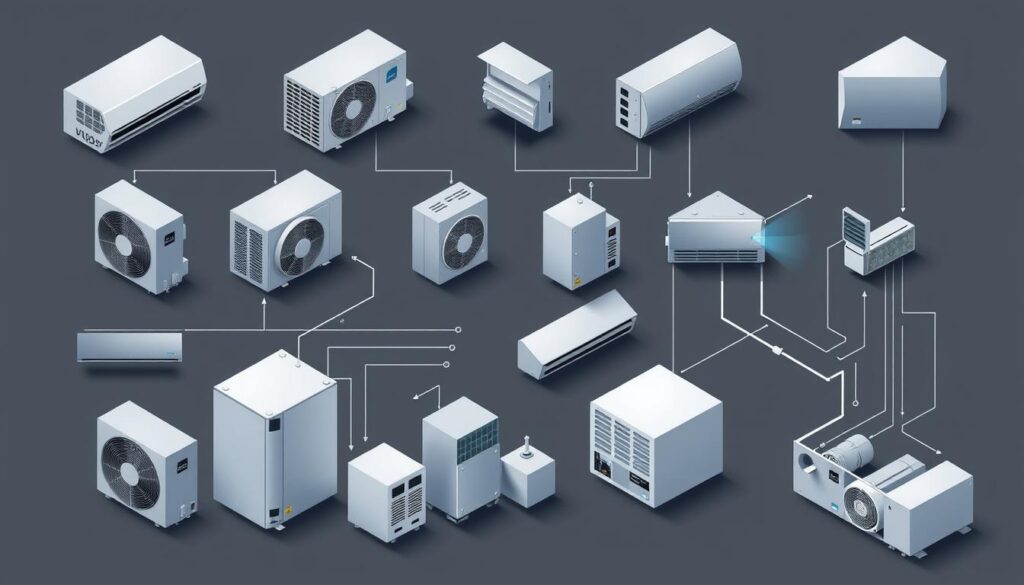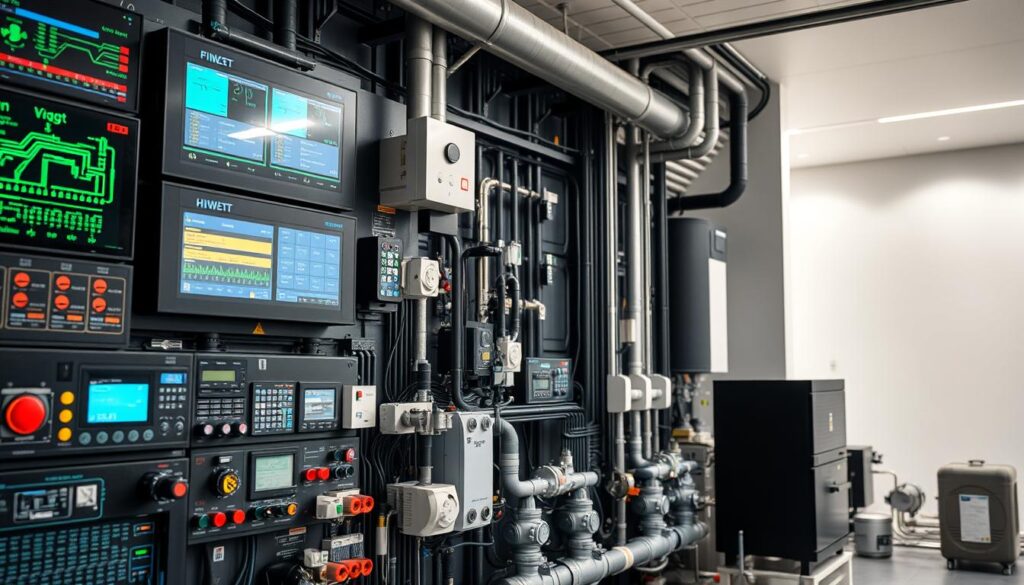Affiliate Disclosure
HVAC Guide Guys is a participant in the Amazon Services LLC Associates Program, an affiliate advertising program designed to provide a means for sites to earn advertising fees by advertising and linking to Amazon.
How HVAC Works in Building? Ever wondered what keeps your indoor environment perfectly comfortable, even when temperatures outside are extreme? Understanding how HVAC works in building environments reveals a complex system designed to transform your living and working spaces into havens of comfort.

HVAC systems are sophisticated networks that manage temperature, humidity, and air quality in buildings. By integrating heating, ventilation, and air conditioning technologies, these systems create environments where people can thrive comfortably.
Modern HVAC system components work seamlessly to regulate indoor climates. They adapt to changing external conditions, ensuring consistent comfort while maintaining energy efficiency. From office towers to residential homes, these systems play a critical role in creating livable spaces.
Key Takeaways
- HVAC systems manage temperature, humidity, and air quality
- Comfort is defined by 80% occupant satisfaction
- Systems consist of central plant, distribution, and rejection units
- Energy efficiency varies between 13-20 SEER ratings
- Proper maintenance prevents 75% of possible system failures
Table of Contents
Understanding HVAC Systems: Core Functions and Purpose
HVAC systems keep our spaces comfortable, working hard to make them just right. They do more than just heat or cool – they control the whole indoor climate with skill.
At its heart, an HVAC system has three main jobs: heating, ventilation, and air conditioning. These parts work together to make the indoor air perfect, managing temperature and air quality.
Definition and Basic Principles
An HVAC system is a complete solution for indoor comfort. It uses heat transfer to control the environment, based on thermodynamics and fluid dynamics.
- Regulates indoor temperature
- Controls humidity levels
- Filters and circulates air
- Maintains air quality
Goals of HVAC Systems
HVAC systems do more than just control temperature. They aim to:
- Ensure human comfort
- Improve indoor air quality
- Optimize energy efficiency
- Protect building infrastructure
Role in Indoor Climate Control
Modern HVAC systems aim to create perfect living and working spaces. Approximately 90% of U.S. homes rely on these systems to keep temperatures just right all year.
“HVAC systems are not just about temperature – they’re about creating the perfect indoor ecosystem.” – HVAC Engineering Experts
With smart thermostats and zoned temperature control, these systems can cut energy bills by 10-30%. They make indoor climate management both comfy and affordable.
Essential Components of Building HVAC Systems
Knowing the main parts of an HVAC system is key for good climate control. Your HVAC guide starts with the basic elements that keep your space comfy.
- Thermostat: The control center that manages temperature settings
- Compressor: Often called the system’s “heart”, responsible for circulating refrigerant
- Condenser and Evaporator Coils: Critical for heat exchange processes
- Air Handler: Manages air circulation throughout the building
- Ductwork: Network for distributing conditioned air
“The efficiency of an HVAC system depends on the seamless integration of its components.” – HVAC Engineering Professionals
Heat pumps are popular in today’s HVAC systems. They can work in temperatures as low as zero degrees Fahrenheit, providing both heat and cool air. But, cheaper models might need extra heat when it’s really cold.
| Component | Key Function | Maintenance Frequency |
|---|---|---|
| Compressor | Refrigerant Circulation | Annual Professional Inspection |
| Air Filters | Air Quality Control | Every 2 Months |
| Thermal Expansion Valve | Refrigerant Flow Regulation | Biannual Check |
Regular upkeep is vital. Half of HVAC issues come from parts other than the compressor. Experts say get professional tune-ups twice a year. Do it in fall for heating and spring for cooling to avoid sudden failures and keep things running smoothly.
Explore Our HVAC Shop
Looking for top-rated HVAC tools, parts, and accessories? Visit our shop and find the perfect solution for your needs.
Visit the ShopHow HVAC Works in Building: The Complete Process
Learning about HVAC systems means exploring heating, cooling, and ventilation. These systems keep buildings comfortable all year round.
Modern HVAC systems use complex methods to improve air quality and temperature. Let’s look at the main steps that make these systems work well.
The Heating Process Explained
The heating process in HVAC systems uses different ways to warm the air. Common methods include:
- Natural gas furnaces
- Electric resistance heaters
- Heat pumps
- Propane-powered systems
Natural gas and propane furnaces heat the air by burning fuel. Heat pumps are more energy-efficient, working best when it’s not too cold outside.
Cooling Cycle Steps
The cooling process in HVAC systems involves several key steps:
- Compression of refrigerant gas
- Condensing to release heat
- Expanding to lower temperature
- Evaporating to absorb indoor heat
The condenser’s liquid is usually 25°F warmer than outside air. This shows how precise the system is.
Ventilation Mechanics
Ventilation is key for good air quality and system performance. It’s important to have clean filters, clear ducts, and check for leaks.
“Ventilation is the lungs of any HVAC system, ensuring fresh air circulation and removing possible contaminants.”
| HVAC Component | Key Function | Typical Lifespan |
|---|---|---|
| Heat Pumps | Heating and Cooling | 7 Years |
| Roof Top Units | Compact Climate Control | 10-15 Years |
| Chillers | Large Space Cooling | 15-20 Years |
Understanding these processes shows the advanced technology behind keeping indoor spaces comfortable.
Explore Our HVAC Shop
Looking for top-rated HVAC tools, parts, and accessories? Visit our shop and find the perfect solution for your needs.
Visit the ShopTypes of HVAC Systems for Buildings
Choosing the right HVAC system is key for comfort and saving energy. About 80% of buildings use HVAC systems. Knowing the types can help you pick the best one for your needs.

Different parts of an HVAC system affect its performance and energy use. Let’s look at the most common types:
- Central Air Systems: Great for big buildings, these systems heat and cool through a central unit.
- Heat Pumps: These are energy savers, cutting electricity use for heating by up to 50%.
- Ductless Mini-Splits: These systems are very efficient, using 25-50% less energy than traditional HVAC.
- Hybrid Systems: They mix technologies to save even more energy.
New HVAC trends include zoned systems, which can save up to 30% energy by focusing on specific areas.
The right HVAC system can greatly improve comfort and energy use in any building.
Here’s a quick look at what each system offers:
| System Type | Energy Efficiency | Best Suited For | Cost Efficiency |
|---|---|---|---|
| Central Air | 50-70% of total costs | Large commercial buildings | High initial investment |
| Heat Pumps | Up to 50% reduction | Moderate climate regions | Medium investment |
| Ductless Mini-Splits | 25-50% more efficient | Small to medium spaces | Lower installation costs |
When picking an HVAC system, think about your building’s size, climate, energy goals, and budget. Talking to HVAC experts can guide you to the best choice for your needs.
Distribution Systems and Air Flow Management
Managing air distribution is key to HVAC system performance. Your building’s comfort and energy efficiency depend on complex hvac air distribution networks. These networks move conditioned air through different spaces.
Effective hvac system components work together for optimal air circulation, temperature control, and indoor air quality. Knowing how these systems work can help you enjoy better comfort and save energy.
Ductwork Design and Function
Ductwork is the heart of your HVAC system. Well-designed ducts can greatly improve system efficiency:
- Minimize air leakage
- Ensure uniform air distribution
- Reduce energy consumption
- Maintain consistent indoor temperatures
Air Handler Units (AHUs)
Air Handler Units are vital for conditioning and circulating air. They handle several important tasks:
- Filter indoor air
- Heat or cool air
- Control humidity levels
- Manage ventilation rates
“Proper air distribution can reduce heating and cooling costs by up to 30%.” – HVAC Engineering Insights
Ventilation Networks
Sophisticated ventilation networks are key for indoor air quality. They manage air intake, circulation, and exhaust, ensuring a healthy and comfortable space.
By using advanced hvac air distribution strategies, you can save a lot of energy and improve your building’s performance.
Explore Our HVAC Shop
Looking for top-rated HVAC tools, parts, and accessories? Visit our shop and find the perfect solution for your needs.
Visit the ShopCentral Plant Operations and Cooling Towers
Central plants and cooling towers are key in managing building temperatures. They keep cooling processes efficient. These systems are vital for climate control in big buildings and factories.
Cooling towers are vital in water-cooled HVAC systems. They remove excess heat from chillers into the air. They cool water down to 75°F-80°F during hot summers.
- Cooling towers can exceed heights of 200 ft
- Used in power generation, oil refineries, and thermal stations
- Provide more energy-efficient cooling compared to air-cooled systems
Central plants use advanced chillers that work in temperatures from 70°F to over 100°F. Water-cooled chillers use cooling tower water to cool down. This makes cooling big areas more affordable.
“Cooling towers help save significant amounts of water and energy compared to traditional air-cooled systems.” – HVAC Engineering Experts
For best performance, consider these:
- Regular water treatment programs
- Managing challenges like corrosion and scale
- Monitoring microbiological activity
Professional water treatment is key for these complex systems. It keeps them running well and saves time and money.
Energy Efficiency and System Performance
HVAC energy efficiency is key for those wanting to cut down on energy use and lower bills. Today’s HVAC systems use new tech to boost performance and be more eco-friendly.
Knowing how to measure HVAC efficiency helps you choose the right heating and cooling. Let’s look at what matters most for energy use:
SEER Ratings Explained
The Seasonal Energy Efficiency Ratio (SEER) is vital for air conditioners. A higher SEER means better energy use. For instance:
- Old systems might have SEER ratings around 8-10
- New systems can hit SEER ratings of 16-22
- Every point up means big energy savings
Energy-Saving Features
New HVAC trends bring cool energy-saving tech:
- Variable-speed motors that adjust power use
- Smart thermostats that learn your habits
- Heat recovery ventilators that save energy
Optimization Strategies
Boost your HVAC’s efficiency with these tips:
- Regular maintenance keeps systems running well
- Choose the right size for your space
- Use advanced control systems
“Investing in energy-efficient HVAC tech can cut energy use by up to 50%.”
By focusing on these areas, you can make your HVAC system work better. This will lower your energy bills and help the planet.
Explore Our HVAC Shop
Looking for top-rated HVAC tools, parts, and accessories? Visit our shop and find the perfect solution for your needs.
Visit the ShopHVAC Control Systems and Automation

The world of HVAC control systems has changed a lot in recent years. New technologies and trends in the HVAC industry have led to big changes. Now, buildings use advanced automation that’s way beyond simple thermostats.
Smart HVAC control systems are a big step forward in managing buildings. They offer amazing abilities to monitor and control the environment. They also help save a lot of energy.
“The future of building comfort is intelligent, connected, and responsive.” – HVAC Technology Experts
Today’s HVAC control systems have some key features:
- Remote operational capabilities
- Adaptive learning algorithms
- Integration with smart home devices
- Predictive maintenance technologies
The market is showing the impact of these new technologies. The HVAC controls market is expected to grow from USD 13.6 billion in 2018 to USD 27.0 billion by 2023. This shows how fast the industry is moving.
| Control System Type | Key Characteristics | Energy Efficiency |
|---|---|---|
| Pneumatic Controls | Cost-effective, industrial applications | Moderate |
| Direct Digital Controls (DDC) | Precise, remote monitoring | High |
| Smart IoT Systems | Adaptive, interconnected | Very High |
As buildings get smarter, HVAC systems are changing too. They’re becoming part of the bigger infrastructure. This means better comfort, efficiency, and sustainability for buildings.
Maintenance Requirements and Best Practices
Keeping your HVAC system in top shape is key for its performance, energy use, and lifespan. Following good hvac maintenance tips can prevent expensive fixes and make your heating and cooling last longer.
Knowing how to troubleshoot your hvac can save you money and time. Regular upkeep stops sudden failures and keeps your system efficient.
Regular Maintenance Schedule
A good maintenance plan includes both DIY tasks and expert checks. Here’s a suggested routine:
- Monthly: Check and swap out air filters
- Quarterly: Clean air vents and registers
- Biannually: Get a professional to inspect your system
- Annually: Do a deep clean and full system check
Common Issues and Solutions
| Problem | Potential Cause | Solution |
|---|---|---|
| Reduced Airflow | Clogged Filters | Replace filters regularly |
| Inconsistent Temperatures | Thermostat Malfunction | Calibrate or replace thermostat |
| Strange Noises | Loose Components | Professional inspection |
Professional Service Guidelines
While you can do some maintenance yourself, expert help is vital for:
- Complex system checks
- Refrigerant level checks
- Electrical component checks
- Full system performance review
“Preventative maintenance is always more cost-effective than emergency repairs.” – HVAC Industry Expert
By following these hvac maintenance tips and knowing basic troubleshooting, you can greatly improve your system’s performance and reliability. Regular care can prevent sudden failures and save you up to 30% on energy costs.
Explore Our HVAC Shop
Looking for top-rated HVAC tools, parts, and accessories? Visit our shop and find the perfect solution for your needs.
Visit the ShopSystem Design Considerations for Different Buildings
Creating an effective HVAC installation guide needs a deep look at many building features. You must design HVAC systems that fit unique architectural needs, how people use the space, and the local weather.
Different buildings need special HVAC setups. The hvac industry trends show key things that shape system design:
- Building size and layout
- Occupancy patterns
- Geographic climate zone
- Energy efficiency goals
For homes, think about compact systems with zone controls for temperature. Commercial places need more complex systems to handle different numbers of people.
| Building Type | Key Design Considerations | Recommended System |
|---|---|---|
| Residential | Personal comfort, energy efficiency | Split system, heat pump |
| Commercial | Multiple zones, high occupancy | VRF, rooftop units |
| Industrial | High-volume airflow, temperature control | Large central systems |
Energy efficiency is very important. Modern HVAC designs use smart technologies and green energy to work better and save money.
“The right HVAC system transforms a building from merely functional to truly comfortable.” – HVAC Design Expert
Your main goal is to make a system that offers comfort, saves energy, and is good for the planet in all kinds of buildings.
Conclusion
Knowing how HVAC works in buildings is key, as we spend about 90% of our time inside. HVAC technology keeps evolving, changing how we feel comfortable indoors and save energy. Your HVAC system does more than just control the temperature. It’s a complex system that makes your home or office better.
HVAC energy efficiency is now a big deal in building design. Energy Star-rated systems can cut energy use by up to 50%. This means big savings for the planet and your wallet. Smart thermostats can save homeowners about $180 a year. Plus, new systems can make the air inside your home cleaner, cutting pollutant levels by 40-60%.
New HVAC technologies are coming out all the time. We’re seeing things like geothermal systems and Variable Refrigerant Flow (VRF) systems. These advancements mean better control over your indoor climate. Keeping up with these changes helps you choose the best systems for your needs.
The HVAC market is expected to hit $160 billion by 2027. So, getting efficient, well-kept systems is essential. Regular upkeep, smart upgrades, and knowing your system’s strengths will keep it running well. This means more comfort, savings, and energy efficiency for years ahead.

